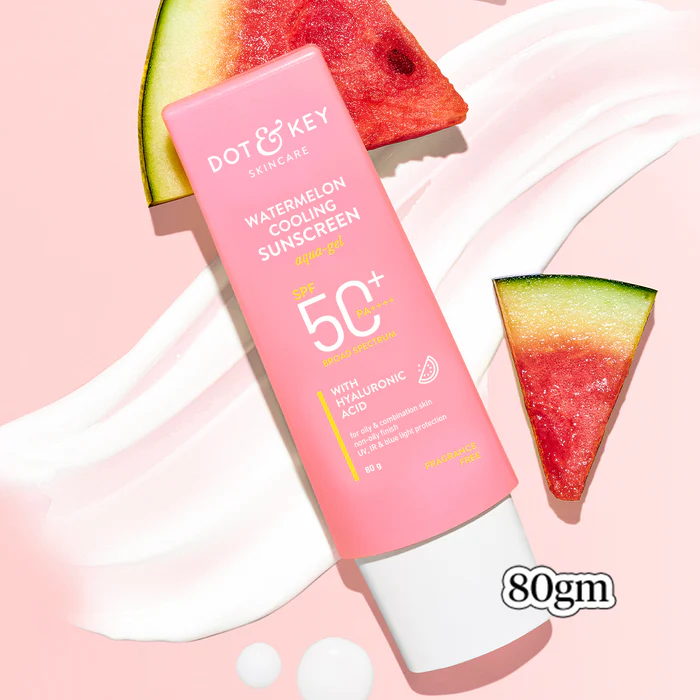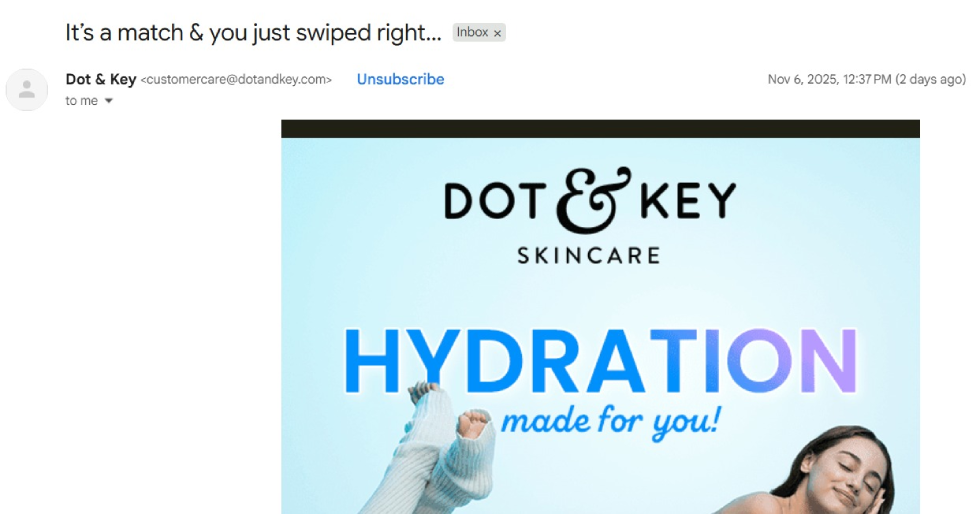
In 2019, when Dot & Key launched, India’s skincare market was dominated by legacy brands like Lakme and premium imports like The Ordinary. Within five years, Dot & Key carved out a distinct position: affordable yet effective, ingredient-focused yet approachable and digital-native whilst expanding into traditional retail.
By FY2025, Dot & Key reportedly generated over ₹500 crore in annual revenue, is available in 20,000+ retail outlets in various sizes and has become synonymous with “fun, fruit-forward skincare that actually works.” This wasn’t accidental. It was the result of a precisely executed marketing playbook that prioritised awareness over immediate ROI, creators over traditional advertising and community over one-way brand messaging.
For any brand that works with a digital marketing agency that wants exponential D2C scaling or beauty brands navigating India’s competitive landscape, Dot & Key offers invaluable lessons in moving fast, testing constantly and building brand equity whilst driving performance simultaneously.
Table of Contents:
- Why Dot & Key Matters Now
- Brand Positioning: Making Skincare Fun and Accessible
- The Marketing Channel Playbook
- Creative Strategy and Brand Identity
- Competitor Positioning and Market Perception
- Marketing Lessons for D2C Brands
- Concluding Thoughts
- FAQ’s
Why Dot & Key Matters Now
Dot & Key’s emergence coincided with three significant market shifts that the brand capitalised on brilliantly.
- The D2C Boom: India’s direct-to-consumer revolution accelerated post-2018. Consumers, particularly millennials and Gen Z, showed willingness to trust new digital-native brands over legacy players. Dot & Key entered precisely when consumer behaviour was shifting.
- The Ingredient-Consciousness Wave: Western skincare trends emphasising specific active ingredients (niacinamide, vitamin C, hyaluronic acid) reached Indian consumers through social media. Dot & Key positioned products around these trending ingredients whilst keeping formulations suited to Indian skin and climate.
- The Creator Economy Explosion: Instagram and YouTube influencers gained unprecedented trust and reach. Beauty content creators became primary sources for skincare recommendations. Dot & Key bet heavily on this channel from day one.
The Result: Dot & Key grew from zero to ₹100 crore revenue in three years and doubled again to ₹300+ crore by year five. The brand became the third-largest skincare player on Nykaa and Amazon Beauty whilst maintaining healthy D2C margins.
Brand Positioning: Making Skincare Fun and Accessible
Dot & Key’s core positioning differentiates it from both legacy brands and premium competitors through three deliberate strategic choices.
Ingredient-Focused Without Being Clinical: Unlike premium brands that positioned ingredients as scientific and serious, Dot & Key made them approachable. Product names like “Watermelon Hyaluronic Cooling Sunscreen” communicated key actives whilst feeling accessible, not intimidating.

Fruit-Forward, Visually Delightful Packaging: In a category dominated by white, clinical packaging or luxe minimal aesthetics, Dot & Key chose vibrant, fruit-forward designs with pops of colour that photographed beautifully for social media. The packaging wasn’t just pretty. It was strategically designed for Instagram shareability.
Affordable Yet Aspirational Pricing: Dot & Key positioned between mass-market brands (₹200-400) and premium imports (₹1,500+), occupying the ₹500-1,200 sweet spot. This pricing felt accessible for experimenters whilst being high enough to signal quality.
The Marketing Channel Playbook
Dot & Key’s channel strategy prioritised awareness and education over immediate conversion, then layered performance marketing to capture demand created through brand building.
Influencer and Creator Marketing: The Foundation
Dot & Key’s influencer strategy wasn’t about one-off paid posts. It was about building an ecosystem that turned creators into genuine brand advocates.
The approach: Early-stage focus on micro and mid-tier influencers (10K-500K followers) rather than celebrities. These creators had higher engagement rates, lower partnership costs, and audiences that trusted recommendations more.
Execution tactics: Seeding products for organic reviews (not all paid), long-term ambassador relationships rather than transactional posts, encouraging honest reviews including constructive feedback, featuring creator content in brand marketing and co-creating products with influencer input.
The impact: Dot & Key reportedly works with thousands of creators regularly. This creates sustained visibility across different audience segments whilst maintaining authenticity. When multiple trusted creators recommend the same product independently, consumer trust compounds exponentially.
Performance Marketing: The Conversion Engine
Once awareness existed through influencer content, Dot & Key deployed aggressive performance marketing to capture demand through Google Shopping ads, Facebook and Instagram retargeting, Amazon and Flipkart sponsored listings and Nykaa promoted placements.

The strategy difference: Rather than cold prospecting, performance ads primarily retargeted users who had engaged with influencer content or visited the website. This warm audience approach improved conversion rates dramatically.
Creative testing discipline: Dot & Key reportedly tests 50-100 ad variations monthly, killing underperformers within days and scaling winners aggressively. This rapid-test-and-scale approach is more typical of tech startups than traditional beauty brands.
OTT and Streaming Sponsorships
As Dot & Key scaled, the brand moved beyond social media into OTT platform sponsorships like MX Player to reach broader audiences. These sponsorships served awareness and credibility goals, positioning Dot & Key alongside established FMCG brands whilst maintaining a digital-first identity.
Omnichannel Rollout: From D2C to Everywhere
- D2C app and website: Direct customer relationships, highest margins, first-party data collection and the ability to test new products. The D2C channel maintains premium pricing while offering subscription benefits.
- Marketplace presence (Nykaa, Amazon, Flipkart): Mass reach, consumer trust through established platforms and access to customers who prefer marketplace shopping. Dot & Key became a top-performing brand on these platforms within three years.
- Offline retail ( 15,000+ outlets): Traditional retail distribution provides physical product trial and credibility. Offline presence signals “real brand” status compared to digital-only players.
Managing pricing, inventory and brand consistency across channels whilst maintaining profitability required channel-specific SKUs, exclusive launches and dynamic pricing strategies.
Retention and Community Marketing
Acquisition marketing gets customers to their first purchase. Retention marketing drives repeat purchases. Dot & Key invests significantly in email and SMS flows based on purchase behaviour, subscription programmes offering discounts, loyalty points through purchases and reviews, early access to new launches and personalised recommendations.

Dot & Key actively encourages user-generated content through hashtag campaigns, featuring customer reviews in marketing and creating exclusive communities for brand advocates. Brands in skincare typically see 15-20% repeat purchase rates. Dot & Key reportedly achieves 35-40% repeat rates, dramatically improving unit economics.
Creative Strategy and Brand Identity
Dot & Key’s creative strategy balances fun and functional, aspirational and accessible.
- Visual Identity: Bright, fruit-forward packaging with clear ingredient callouts creates instant shelf recognition. Product photography emphasises texture, colour and sensory experience rather than clinical efficacy shots.
- Tone of Voice: Conversational, educational and enthusiastic. Dot & Key explains skincare science without condescension, uses everyday language and maintains optimism about results without unrealistic promises.
- Campaign Strategy: Rather than big-budget national campaigns, Dot & Key focuses on always-on digital content: educational content about ingredients, trend-jacking around viral skincare topics, seasonal campaigns tied to weddings and festivals and product launches leveraging influencer partnerships.
- The creative principle: Every piece of creative should either educate, entertain or inspire action. Content that doesn’t drive one of these outcomes doesn’t run.
Competitor Positioning and Market Perception
Direct Competitors:
- Minimalist: More clinical positioning and slightly lower pricing. Attracts hardcore skincare enthusiasts compared to Dot & Key’s mainstream appeal.
- Plum: Established earlier with a stronger vegan positioning. Skews slightly older demographically versus Dot & Key’s younger, social-first consumers.
- The Derma Co: Dermatologist-backed positioning and a clinical aesthetic. Attracts consumers seeking medical credibility versus Dot & Key’s fun, approachable skincare.
- Dot & Key’s Differentiators: Stronger influencer ecosystem and social presence, vibrant youth-focused brand identity, faster product innovation cycle (20–30 SKUs annually) and superior omnichannel execution balancing D2C, marketplaces and offline.
Market Perception:
- Positive drivers: “Actually works” sentiment, “affordable effectiveness” positioning, “fun to use” sensory experience and “trustworthy brand” transparency.
- Criticism: “Too many launches” concerns about focus, “fragrance sensitivity” feedback from some users, “availability issues” with popular products selling out and “marketplace discounting” creating pricing confusion.
- Industry Positioning: Analysts position Dot & Key as India’s fastest-growing skincare brand in the affordable-premium segment and a credible challenger to legacy brands in the under-30 demographic.
Marketing Lessons for D2C Brands
Dot & Key’s journey offers tactical and strategic lessons applicable beyond skincare.
1. Awareness Before Performance: Dot & Key invested heavily in awareness (influencer marketing, content creation) before aggressive performance marketing. This created warm audiences that converted efficiently when retargeted. Build awareness first, then layer performance marketing.
2. Influencers as Co-Creators: Dot & Key’s influencer relationships go beyond transactional paid posts. Creators provide product feedback and share honest reviews. This authenticity builds trust. Treat influential creators as partners in brand building, not just advertising channels.
3. Creative Testing at Startup Speed: Testing ad creative with tech startup discipline (launch dozens of variations, kill losers within days, scale winners aggressively) dramatically improves efficiency. Working with a digital marketing agency that can execute rapid testing cycles daily (not monthly) improves performance marketing results.
4. Omnichannel Requires Channel-Specific Strategy: Each channel serves specific purposes: D2C for margins and data, marketplaces for reach, and offline for trial. Channel-specific SKUs, pricing and promotions prevent channel conflict whilst maximising total revenue.
5. Retention Marketing Improves Unit Economics: Dot & Key’s 35–40% repeat rate versus the industry average of 15–20% means they can spend more acquiring customers whilst maintaining profitability. Doubling repeat purchase rates allows doubling acquisition spend whilst maintaining overall profitability.
6. Product Innovation Pace Creates Advantage: Launching 20–30 new SKUs annually versus competitors’ 5–10 creates constant newness and maintains interest. In fast-moving categories, innovation velocity often matters more than perfection.
Concluding Thoughts
Dot & Key’s rapid growth from launch to ₹300+ crore revenue in five years demonstrates that a thoughtful marketing strategy can overcome resource constraints and incumbent advantages. The brand succeeded through strategic channel selection (influencers over TV), rapid execution (testing and scaling at startup speed) and genuine customer focus (listening to feedback and building community).
The Indian skincare market continues evolving rapidly. Dot & Key’s continued success will depend on maintaining innovation velocity, managing omnichannel complexity and deepening customer relationships as competition intensifies.
For brands looking to replicate elements of Dot & Key’s success, the core principles remain applicable: build awareness before demanding conversions, treat creators as partners, test and iterate relentlessly, design channel strategies that leverage each channel’s unique value and invest in retention marketing from the beginning.



